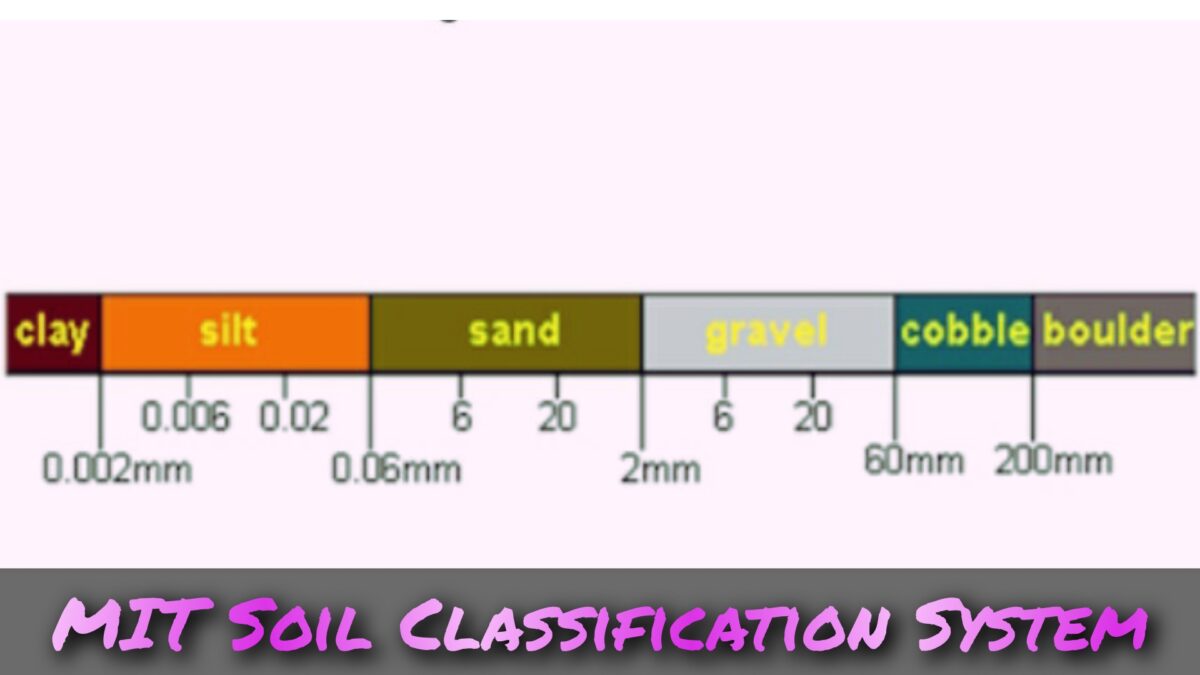Table of Contents
What Is MIT Soil Classification System?
The MIT soil classification system was devised by the Massachusetts Institute of Technology (MIT). This type of soil classification system is popular all over the world. The MIT soil classification system uses the engineering properties of soils.

I this blog article, I will discuss the MIT Soil Classification System, including its purpose, classification criteria, and the different soil types recognized within the system.
Purpose Of The MIT Soil Classification System:
The primary objective of this classification system is to give a standard classification of soils based on mechanical properties.
The MIT classification system helps engineers and geotechnical professionals understand the behavior of different soil types, aiding in the selection of appropriate construction methods and design considerations.
The system takes into account key soil properties such as grain size, stability and plasticity to classify soils into different groups.
Classification Criteria
Various parameters are used for the classification of soils in the MIT system. These criteria include grain size distribution, plasticity, stability and organic content.
By assessing these soil properties, soils can be classified into different groups, each with their own unique characteristics and engineering behaviour.
In the following parts, we will talk about the factors and different kinds of soil in the MIT Soil Classification System.
1. Grain Size Distribution:
Grain size distribution is a fundamental factor in soil classification. The MIT system categorizes soils based on their percentages of coarse-grained and fine-grained particles.
The system employs a triangular chart, known as the “MIT Grain Size Distribution Chart,” to classify soils into groups based on their grain size characteristics. The chart represents the percentage of gravel, sand, silt, and clay particles in a soil sample, allowing for easy identification of soil types.
2. Consistency:
Consistency refers to the ability of a soil to change its shape and maintain its structure. The MIT Soil Classification System evaluates consistency using three primary parameters: liquid limit (LL), plastic limit (PL), and plasticity index (PI).
These parameters help determine whether a soil is cohesive or non-cohesive and provide insights into its engineering properties. Soils are classified as cohesive or non-cohesive based on their consistency values.
3. Plasticity:
Plasticity is a crucial property of fine-grained soils. It characterizes the ability of soil particles to undergo deformation without cracking or crumbling.
The plasticity index (PI), calculated as the difference between the liquid limit (LL) and plastic limit (PL), is used to classify soils based on their plasticity. Soils can be classified as low plasticity, medium plasticity, or high plasticity based on their PI values.
4. Organic Content:
The presence of organic materials significantly affects soil behavior and engineering properties. The MIT Soil Classification System takes into account the organic content of soils as a separate parameter.
Soils with high organic content may exhibit different engineering characteristics compared to soils with low or no organic content. This criterion allows engineers to consider the impact of organic materials when designing foundations, embankments, or other geotechnical structures.
Soil Types In The MIT Soil Classification System:
The MIT Soil Classification System classifies soils into various types based on the aforementioned criteria. The following table provides a summary of the soil types and their corresponding classification parameters within the system:
| Soil Type | Grain Size Distribution | Consistency | Plasticity | Organic Content |
|---|---|---|---|---|
| Gravel | >50% gravel | Non-cohesive | N/A | Low |
| Sand | >50% sand | Non-cohesive | N/A | Low |
| Silt | >50% silt | Cohesive | Low | Low |
| Clay | >50% clay | Cohesive | High | Low |
| Silty Gravel | Gravel + silt | Non-cohesive | Low | Low |
| Silty Sand | Sand + silt | Non-cohesive | Low | Low |
| Silty Clay | Clay + silt | Cohesive | Medium | Low |
| Sandy Silt | Sand + silt | Cohesive | Low | Low |
| Sandy Clay | Clay + sand | Cohesive | High | Low |
| Organic Clay | >50% clay | Cohesive | High | High |
| Organic Silt | >50% silt | Cohesive | Medium | High |
| Organic Sand | >50% sand | Non-cohesive | N/A | High |
| Organic Gravel | >50% gravel | Non-cohesive | N/A | High |
Note: N/A indicates not applicable.
Sum Up:
The MIT Soil Classification System is a way to group soils based on how they behave when we use them for construction or engineering projects. It helps engineers and geotechnical professionals understand the different properties of soils by looking at things like how big the soil particles are, how sticky or solid the soil feels, how much it can be molded, and how much organic material it contains.
By putting soils into different categories, we can make better decisions about how to design and build things like buildings, roads, and foundations. This system is useful because it provides a clear framework for understanding soil behavior and characteristics.
To make it easier to use in the real world, the MIT Soil Classification System includes tables and charts, such as the MIT Grain Size Distribution Chart.

These tools help engineers and professionals apply the system in their work, making it a valuable resource in geotechnical engineering
